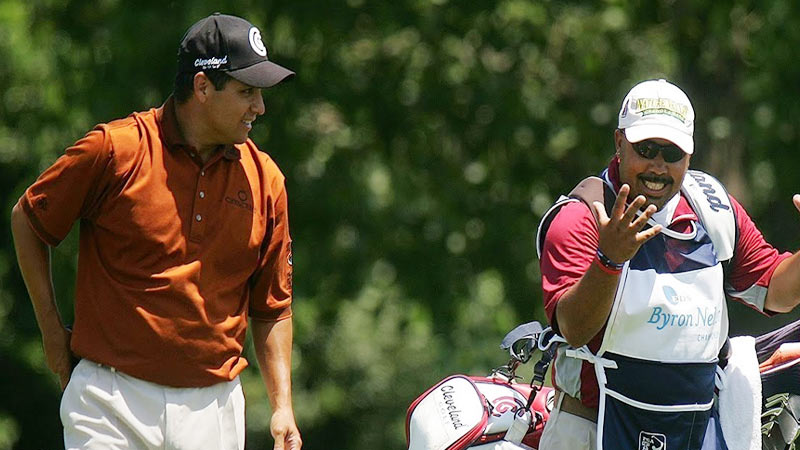In the world of golf, the role of a caddy goes far beyond carrying a bag of clubs. These unsung heroes of the fairway provide a unique blend of support, guidance, and camaraderie that can significantly impact a golfer’s performance and overall experience on the course.
Whether you’re a seasoned golf enthusiast or a newcomer to the game, understanding the pivotal role of a caddy and the intricacies of their job can offer new perspectives on the sport.
In this blog post, we’ll delve into the world of golf caddies, addressing some of the most frequently asked questions that shed light on their responsibilities, earnings, and even their choice of footwear. So, stay focused.
What Is A Caddy In Golf?
In the realm of golf, a caddy (also spelled “caddie”) plays an essential role as a supportive companion for a player during their round. The caddy is responsible for carrying the golfer’s bag containing clubs, balls, and other necessary equipment, thereby allowing the player to focus solely on their shots.
Beyond physical assistance, caddies provide valuable guidance and advice regarding course conditions, yardages, and strategic choices. They possess an intimate familiarity with the course, aiding golfers in making informed decisions to optimize their performance.
Additionally, caddies offer moral support, helping players maintain a positive mindset and encouraging them throughout the game.
Their dual function of carrying equipment and providing strategic insights makes caddies indispensable partners, contributing to a more efficient and enjoyable golfing experience for the players they assist.
Responsibilities of a Caddy in Golf
A golf caddy takes on various responsibilities to enhance a player’s performance and overall experience on the course. These responsibilities include:
Club and Equipment Management
Carrying and managing the golfer’s clubs, ensuring they have the appropriate club for each shot, and keeping the equipment clean and in proper condition.
Course Knowledge
Providing insights about the course layout, distances to hazards and greens, and suggesting optimal shot strategies based on their familiarity with the course.
Yardage Calculation
Assisting the golfer in accurately calculating distances to targets, hazards, and greens, helping them choose the right club for the shot.
Reading Greens
Offering advice on reading greens, slopes, and breaks, aids the golfer in making accurate putting decisions.
Moral Support
Offering encouragement and maintaining a positive attitude throughout the round to keep the golfer focused and motivated.
Club Selection
Recommending club choices based on factors like wind conditions, the lie of the ball, and the golfer’s abilities.
Carrying Bag
Physically carrying the golfer’s bag which can be quite demanding, especially on courses with challenging terrain.
Raking Bunkers
Raking sand bunkers after the golfer’s shot to ensure fair playing conditions for everyone.
Cleaning Equipment
Cleaning clubs and balls to maintain their optimal performance.
Fetching Balls
Locating and retrieving golf balls after shots, especially in areas where visibility might be limited.
Maintaining Pace of Play
Assisting in keeping a steady pace of play by managing the golfer’s equipment and being prepared for shots.
Personalized Advice
Providing individualized advice based on the golfer’s strengths, weaknesses, and playing style.
Course Etiquette
Advising the golfer on proper etiquette, such as respecting other players, staying quiet during shots, and adhering to course rules.
Keeping Score
Recording the golfer’s scores and maintaining accurate shot counts throughout the round.
Adapting to Golfer Preferences
Adjusting their approach based on the golfer’s preferences, communication style, and comfort level.
Required Skills of Caddy in Golf

Being a successful golf caddy requires a combination of practical skills, knowledge, and interpersonal abilities. The required skills of a caddy in golf include:
Course Knowledge
A thorough understanding of the golf course layout, including yardages, hazards, and green contours, is essential for providing accurate guidance to the player.
Yardage Calculation
The ability to accurately estimate distances using markers, rangefinders, or visual cues is crucial for helping the player choose the right club for each shot.
Club Selection
The player’s strengths and weaknesses and making appropriate club recommendations based on the specific shot requirements and conditions.
Reading Greens
Skill in assessing green slopes, breaks, and speed, and providing reliable advice to the player for more successful putting.
Communication
Effective verbal and nonverbal communication skills to relay information, offer advice and maintain a positive rapport with the player.
Physical Stamina
The physical strength and endurance to carry a golf bag weighing around 30-40 pounds for an entire round, often on challenging terrains.
Attention to Detail
Paying close attention to the player’s preferences, shot outcomes, and any changes in conditions to adjust strategies accordingly.
Problem-Solving
Being able to adapt to unexpected situations, such as changes in weather or course conditions, and quickly finding solutions to help the player navigate challenges.
Etiquette and Rules
Knowledge of golf etiquette and rules to guide the player in adhering to proper on-course behavior and decisions.
Positive Attitude
Maintaining a positive and encouraging demeanor to keep the player motivated and focused, even during challenging moments.
Empathy and Adaptability
The player’s emotions and adjusting your approach to provide the appropriate level of support and advice.
Quick Thinking
Making informed decisions under time constraints, particularly in fast-paced scenarios like keeping the pace of play.
Organization
Managing the golfer’s equipment, keeping clubs and balls clean, and ensuring everything is for each shot.
Caddy Etiquette
Demonstrating respect for the player’s space, following their lead on conversation, and being mindful of their needs.
Problem-Solving
Being resourceful and creative in finding solutions to unexpected challenges, such as lost balls or difficult lies.
A skilled caddy not only contributes to the player’s performance but also enhances their overall enjoyment of the game. These skills collectively enable a caddy to provide valuable assistance and advice that can significantly impact a golfer’s success on the course.
Types of Gold Caddy
There are two main types of golf caddies: traditional caddying and fore-caddying. Each type serves a different role and provides various levels of assistance to golfers:
Traditional Caddying
Traditional caddies are the most commonly recognized type of caddies in golf. They accompany a golfer throughout the round and provide comprehensive assistance.
Their responsibilities include carrying the golfer’s bag, offering advice on club selection, reading greens, providing yardage calculations, and offering moral support.
Traditional caddies have a deep understanding of the golf course, its layout, and the golfer’s game, which allows them to offer personalized guidance and recommendations. They play an active role in helping the golfer strategize and make informed decisions during the round.
Fore-Caddying
Fore-caddies, on the other hand, have a slightly different role compared to traditional caddies. Instead of accompanying a single golfer, a fore-caddy works ahead of a group of golfers. They are responsible for positioning themselves on the fairway or at vantage points to track the shots of each player in the group.
Fore-caddies help locate balls, provide yardages, and guide players to their shots, reducing the time spent searching for lost balls and expediting play. Fore-caddies are particularly useful in situations where the course is busy, and maintaining a steady pace of play is essential.
Both traditional caddying and fore-caddying have their own merits and are chosen based on the golfer’s preferences, the course’s specific requirements, and the overall golfing experience desired.
Challenges to Be a Gold Caddy
Becoming a successful golf caddy comes with its share of challenges, which require a combination of skills, adaptability, and perseverance. Some of the challenges faced by golf caddies include:
Physical Demands
Carrying a heavy golf bag for an entire round, often on challenging terrains, can be physically demanding and tiring. Caddies need to maintain their stamina and fitness to perform their duties effectively.
Course Knowledge
Acquiring an in-depth understanding of various golf courses, including yardages, hazards, and green contours, requires time and experience. Caddies must continuously familiarize themselves with different courses to provide accurate advice.
Communication Skills
Effective communication with golfers is crucial. Caddies need to convey information clearly and concisely, tailoring their communication style to each golfer’s preferences and personality.
Adapting to Golfer Preferences
Different golfers have varying expectations and communication preferences. Caddies must quickly adapt to different playing styles and personalities to provide the best possible assistance.
Reading Greens
Accurately reading greens and providing some putting advice requires experience and a keen understanding of slopes and breaks. Caddies need to continually refine their skills in this area.
Pressure Situations
During important shots or critical moments in a round, caddies might experience pressure to offer the right advice and keep the golfer focused. Managing pressure is crucial for maintaining composure.
Dealing with Mistakes
Like any profession, mistakes can happen. A caddy might provide inaccurate advice or misread a situation. Learning to handle such situations and move forward is essential.
Pace of Play
Maintaining an appropriate pace of play while ensuring golfers receive the necessary assistance requires careful balance. Caddies must keep the game moving without rushing or feeling rushed.
Weather Conditions
Caddies often work in varying weather conditions, including extreme heat, rain, and cold. Enduring such conditions while performing their duties can be challenging.
Player Dynamics
Working with different personalities and temperaments among golfers can be demanding. Caddies need to navigate potential conflicts and maintain a positive atmosphere.
Continuous Learning
Golf is a complex game with many nuances. Caddies must consistently improve their knowledge of the sport, including rule changes, equipment advancements, and new strategies.
Job Insecurity
Caddy positions can be seasonal or freelance, leading to periods of job instability. Caddies might need to seek opportunities across different courses or during peak golf seasons.
Despite these challenges, being a golf caddy can be rewarding and fulfilling. Overcoming obstacles and gaining experience can lead to personal growth and a deeper appreciation for the sport.
FAQs
How much does a caddy make?
The earnings of a caddy can vary widely based on factors such as the course’s location, prestige, and the golfer’s generosity.
Generally, caddies earn a base fee for their services, which can be supplemented by tips from the golfers they assist. This tip structure often rewards excellent service and course knowledge.
How much does a pro caddy make?
Professional caddies working for elite golfers on major tours can earn considerably higher incomes. Their earnings depend on the success of the golfers they caddy for, as they often receive a percentage of the golfer’s winnings.
For well-established caddies working with top-ranked players, the income can reach six figures annually.
What kind of shoes do professional caddies wear?
Professional caddies prioritize comfortable and supportive footwear to endure the physical demands of a round. Many opt for golf-specific shoes that offer traction, cushioning, and stability.
Some caddies might also wear spiked shoes to maintain grip on various terrains, ensuring they can navigate the course with ease.
What qualifications are needed to become a caddy?
Formal qualifications aren’t typically required to become a caddy, but a deep understanding of golf rules, course strategy, and excellent interpersonal skills are essential. Many caddies start by learning on the job, gaining experience, and honing their skills over time.
Do caddies provide swing advice to golfers?
While caddies offer advice on club selection, yardages, and course management, providing swing advice is less common. Caddies focus on aiding the golfer’s decision-making and overall strategy, leaving swing adjustments to the golfer and their coach.
Wrapping Up
Golf caddies stand as invaluable companions to golfers, offering a blend of expertise, physical support, and encouragement that enriches the game.
From assisting with club choices to providing insights on course conditions, caddies play a pivotal role in enhancing a golfer’s performance.
Whether it’s understanding their earnings, choosing the right footwear, or grasping their qualifications, unlocking the mysteries of caddying can deepen your appreciation for the sport and those who contribute to its spirit. Thank you for your support.







